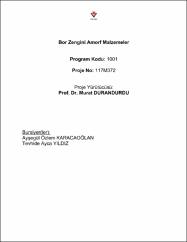| dc.contributor.author | Durandurdu, Murat | |
| dc.date.accessioned | 2024-03-15T12:48:09Z | |
| dc.date.available | 2024-03-15T12:48:09Z | |
| dc.date.issued | 2020 | en_US |
| dc.identifier.uri | https://hdl.handle.net/20.500.12573/2012 | |
| dc.description.abstract | Bu TÜBİTAK 1001 projesi kapsamında, bor zengini farklı amorf malzemeler [B1-xSix, B1-xCx, B1-
xOx, ve B1-xLix (0, 5 ≥ � ≥ 0,05)] ab initio moleküler dinamik tekniği kullanılarak sıvı hallerin hızlıca
soğutulması sonucu modellenmiş ve bu malzemelerin atomik yapıları, elektronik yapıları ve
mekanik özellikleri ayrıntı olarak araştırılmıştır. Bunlara ek olarak, bu malzemelerin bazı
oranlarının yüksek basınçtaki davranışları incelenmiştir. Bazı malzemelerde, örneğin BC ve BO
malzemelerinde, bor oranının artmasıyla iki boyutlu yapıdan üç boyutlu yapıya geçiş
gözlemlenmiştir. Ayrıca yüksek bor oranlarında, B12 icosahedralların oluştuğu bulunmuştur. B12
molekülüne ek olarak nano boyutunda B7, B10, B14, B16 kafes moleküllerinin oluşumu bazı
malzemelerde gözlemlenmiştir. Modellenen malzemelerin her birinin yarıiletken özelliği gösterdiği
fakat yasak band aralığında bor oranına bağlı genel bir eğilim olmayıp dalgalanmaların olduğu
bulunmuştur. B12 moleküllerinin oluşumunun malzemelerin mekanik özelliğini dikkate değer bir
şekilde etkilediği ve bor oranı yüksek olan malzemelerin daha sert bir özellik gösterdiği
bulunmuştur. Yüksek basınç uygulamasıyla, malzemelerin daha yoğun bir amorf yapıya faz
geçişişi yaptığı ve malzemeye bağlı olarak, faz geçişlerinin tersinir ya da tersinir olmayan faz
geçişleri olduğu gözlemlenmiştir. | en_US |
| dc.description.abstract | In this TÜBİTAK 1001 project, different boron-rich amorphous materials [B1-xSix, B1-xCx, B1-
xOx, and B1-xLix (0.5 ≥x≥0.05)] were modeled from the rapid solidification of the melts using ab
initio molecular dynamics technique and their atomic structures, electronic structures and
mechanical properties were studied in details. In addition, the high-pressure behavior of some of
these materials was probed. In some materials, for example in BC and BO, a transition from a
two-dimensional structure to a three-dimensional structure was observed with increasing boron
content. Furthermore, at high boron rates, the formation of B12 icosahedrons was perceived in all
materials. In addition to the B12 molecules, the formation of cage-like nanosized B7, B10, B14, B16
molecules was observed in some materials. Each material modelled showed semiconductor
properties but no trend was detected in the forbidden band gap energy with boron ratio. It was
found that the formation of B12 molecules significantly affects the mechanical properties of
materials and that materials with high boron contents exhibit a high hardness. It was perceived
that with the application of high pressure, all materials undergo a phase transition to a high-density
amorphous state and depending on the materials, phase transitions were observed to be either
reversible or irreversible phase transitions. | en_US |
| dc.language.iso | tur | en_US |
| dc.publisher | TUBİTAK | en_US |
| dc.rights | info:eu-repo/semantics/openAccess | en_US |
| dc.subject | Bor | en_US |
| dc.subject | amorf | en_US |
| dc.subject | ab initio moleküler dinamik | en_US |
| dc.subject | basınç | en_US |
| dc.subject | Boron | en_US |
| dc.subject | amorphous | en_US |
| dc.subject | ab initio molecular dynamics | en_US |
| dc.subject | pressure | en_US |
| dc.title | Bor Zengini Amorf Malzemeler | en_US |
| dc.type | project | en_US |
| dc.contributor.department | AGÜ, Mühendislik Fakültesi, Malzeme Bilimi ve Nanoteknoloji Mühendisliği Bölümü | en_US |
| dc.contributor.authorID | https://orcid.org/0000-0001-5636-3183 | en_US |
| dc.contributor.institutionauthor | Durandurdu, Murat | |
| dc.identifier.startpage | 1 | en_US |
| dc.identifier.endpage | 105 | en_US |
| dc.relation.journal | Tubitak | en_US |
| dc.relation.tubitak | 117M372 | |
| dc.relation.publicationcategory | Diğer | en_US |


















